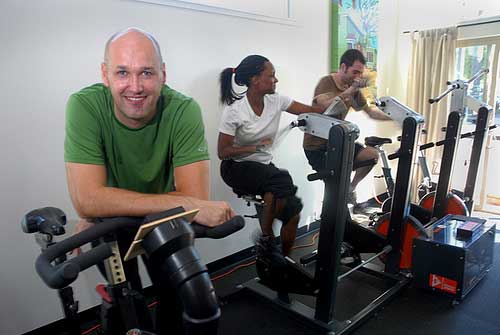Powerful Ideas: Humans as Renewable Sources

Editor's Note: This occasional series looks at powerful ideas — some existing, some futuristic — for fueling and electrifying modern life. This is the first article in the series.
Already abandoned that New Year's resolution to lose a little flab? Recent innovations could inspire an exercise kick with the prospect of human-generated renewable energy.
Case in point is the Green Microgym in Portland, Ore., where users can generate electricity as they burn calories on some of the exercise machines.
"I think it helps some people feel a little bit better about [their workout], and I know people are proud to be a part of the gym because it's green," said gym owner Adam Boesel.
The human engine runs on calories. A bowl of cereal has about 300 calories, which provides enough energy for an hour's worth of walking. Some of that human work could be siphoned off with a special back pack or knee brace to charge a cell phone.
Of course, when you account for all the energy that goes into providing our fuel (food) and running ancillary functions (like our brains), people power is a woefully inefficient way to make electricity.
However, if we can make electricity while doing something we would normally do anyway (like moving in our clothes or opening a door), then the electricity is just a bonus.
Sign up for the Live Science daily newsletter now
Get the world’s most fascinating discoveries delivered straight to your inbox.
Pedal power
Humans have always relied on their own muscles to get around. The most efficient means of human transport is a bicycle.
Tests done in the 1970s found that an average bicyclist pedaling at road speed is producing around 75 watts of power. (Lance Armstrong supposedly generated 500 watts while climbing hills in the Tour de France.)
That's enough juice to run a television, a blender or even a washing machine, as several inventors have shown by rigging stationary bikes to different appliances.
At Boesel's gym, the six specially-outfitted exercise bikes (as well as one elliptical trainer) generate electricity that either charges battery packs or is fed back into the grid.
A typical workout on one of the machines generates about 60 watts, Boesel told LiveScience. He estimates the gym's energy consumption has been cut by about 50 percent, but much of that is due to being smart about turning off unused equipment.
"We haven't created all that much electricity, but because we're focused on saving energy, we are very energy efficient compared to other gyms," he said.
Human traffic
Getting a little extra human input is the same driving factor behind a new revolving door design.
Revolving doors are already considered energy savers because they keep air from leaking out of a building, but this past October a railway station in the Netherlands took the next step by having an electric generator installed on a revolving door.
A single person going through the door will generate enough electricity to power a 50 Watt bulb for one second, said product manager Dirk Groot of Boon Edam, the Dutch company that designed the door.
Over the course of a year, the traffic through the railway station could end up generating 50 kilowatt-hours, or roughly the energy consumed by 5 average American households, Groot said.
A similar idea came out a few years ago to install special floors in crowded areas that could extract energy from human footsteps.
The recently installed door is about twice as hard to push than a typical revolving door, but Groot said this is considered an acceptable increase. And the extra effort apparently hasn't caused any complaints.
"People find it quite funny," Groot said. "You'll see some people go around more than once."
Child's play
The idea that generating your own electricity can be fun has been used in other situations.
A few companies have put tiny generators into yo-yos, which can run an MP3 player or a cell phone for an hour with just a handful of tosses.
Similarly, inventors have created a simple pull-cord generator that can power a laptop computer in developing countries where electrical power is not universally available.
And several programs in Africa are using merry-go-rounds and other playground equipment to pump up fresh water. The PlayPump, for example, can draw 370 gallons per hour with less effort than other human-powered devices, according to the company's website.
"Generally speaking, the children's play can generate the clean water for the community," said Marissa Valdez, a spokesperson for PlayPumps International.
Over 1,000 PlayPumps have been installed throughout Africa.










